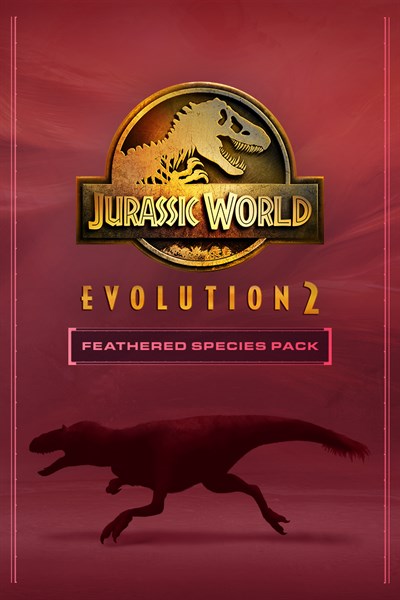Jurassic World Evolution 2: Feathered Species Pack Available Today

Summary
- Expand your park with beautifully feathered dinosaurs and reptiles
- Read our deep dive into four awe-inspiring new prehistoric species
- Pack launches March 30 on Xbox One and Xbox Series X|S
The park of your dreams is about to get even bigger and more diverse with the Jurassic World Evolution 2: Feathered Species Pack. Containing four incredible feathered species in total, you’ll bring a whole new dimension to your park by showcasing these stunning dinosaurs and reptiles, from nimble flying species to land-roaming meat-eaters. Let’s dive deeper into the Feathered Species Pack.
We’re paying tribute to a mix of species that rank as firm favorites, both amongst the community and with everyone here at Frontier Developments. The Yutyrannus and Deinocheirus were especially high in all of the wish lists that our amazing Community Team put together for us to review, whilst the smaller Jeholpterus and Sinosauropteryx resonated really well with our concept, character and animation teams.
In the Jurassic World Dominion blockbuster film, we finally got to see feathered species brought dramatically to life. I wanted our next dinosaur-focused pack to champion species like this. Science is continually evolving our knowledge of extinct lifeforms, and over the last few decades, we’ve learned a tremendous amount about what they could have looked like. This means we’re ensuring every species in the Jurassic World Evolution franchise is as authentic as possible, and it’s great to use this knowledge in order to bring four more exciting and beautiful species to players in this pack.
The pack is a great mix of sizes and types, going from a large ornithomimosaurid and a medium theropod to some of our smallest species yet with the Sinosauropteryx and Jehelopterus. No matter your preferences, the sheer diversity of the species in this pack means there’s something for everyone.
Yutyrannus, The ‘Feathered Tyrant’

Meet the Yutyrannus, one of the largest known feathered dinosaurs to eat meat. The Yutyrannus is covered in a light yet dense coat to provide insulation when the temperature drops, which keeps it warm in colder conditions. I’m especially thrilled with how this looks in the game – try getting a close-up shot using the in-game camera! The name Yutyrannus translates as ‘feathered tyrant’, and it has truly earned that name, being the most fearsome inclusion in this pack.
Jeholopterus, rare and airborne

Next, my personal favourite, the Jeholopterus. Palaeontologists have found only one specimen of this incredibly rare reptile so far, but as luck would have it, it was incredibly well preserved, giving us a fascinating insight into its looks and behavior. As the smallest airborne species in the entire game, the Jeholopterus is an impressively quick and nimble pterosaur, able to dart through the air with beguiling ease and agility. I love its look, sort of a cross between a bat, a bird, and a flying squirrel.
Deinocheirus, omnivore with the hump

Then there’s the Deinocheirus, a highly requested community favorite. One look at this distinctive plant-forager and you can see why. With its duck-like bill and broad hump on its back, this is one of the largest ornithomimosaurs ever discovered, with arms longer than those of any bipedal dinosaur. This is also our first omnivore to eat from both paleobotany trees and from fish feeders, giving you multiple ways to ensure its dietary needs are met.
Sinosauropteryx, pocket-sized but powerful

Onto the Sinosauropteryx, a species at the opposite end of the spectrum to the Deinocheirus and the smallest in our pack. It’s a diminutive, meat-eating dinosaur covered with delicate, hair-like feathers and waving a striped tail. Working together to hunt in groups means the Sinosauropteryx is able to overcome any size disadvantages, making it a formidable species in spite of its stature. It’s also a landmark in the field of feathered dinosaur research. Its fossilized remains were the first to suggest the existence of feathered dinosaurs, and hinted towards their potential for coloration.
By continually researching and comparing how equivalent sized modern day birds look and move with their feathers, we’re able to refine our art processes and pipelines to ensure that our species look as realistic as possible. I’m immensely proud of how we’ve managed to capture these four amazing prehistoric species, and I can’t wait for you to get your hands on them.
It’s been really exciting to bring such unique species to life, and expand on the astounding amount of dinosaurs and reptiles that are currently in the game. Use them to evolve your park even further when the Jurassic World Evolution 2: Feathered Species Pack launches for Xbox Series X|S and Xbox One on 30 March.
Jurassic World Evolution 2: Feathered Species Pack
Frontier Developments
$7.99
$7.19
Expand your Jurassic World with the incredible Jurassic World Evolution 2: Feathered Species Pack. Featuring three land-dwelling dinosaurs and one flying reptile, these four new eye-catching prehistoric species all exhibit magnificent plumage, ranging from dense coverings to fine coats. Evolve your park like never before and give your guests an experience they won’t forget with these captivating feathered additions.
This pack features:
· Yutyrannus has a name that translates as ‘feathered tyrant’ due to it being one of the largest known feathered dinosaurs to eat meat. It has a striking nasal crest used for display purposes, and a light yet dense coat to provide insulation when the temperature drops.
· Jeholopterus is an impressively quick and nimble flying reptile, and the smallest airborne species in the entire game. Palaeontologists have found only one specimen to date, but it ranks among the best preserved of any pterosaur, giving us a fascinating insight into its looks and behaviour.
· Deinocheirus is one of the largest ornithomimosaurs ever discovered, with arms longer than those of any bipedal dinosaur. This distinctive prehistoric species, with its duck-like bill and broad hump on its back, cuts an intimidating figure, despite foraging exclusively on plants.
· Sinosauropteryx, a small, meat-eating dinosaur covered with delicate, hair-like feathers and waving a striped tail. Sinosauropteryx works together to hunt in packs. It was discovered in 1996, and its ancient remains were the first to not only suggest the existence of feathered dinosaurs, but hint at their potential to have colouration.





